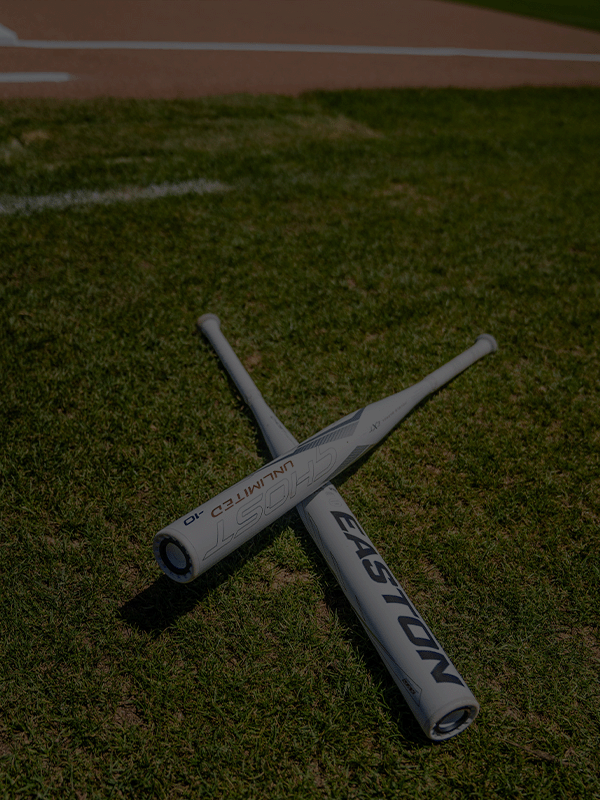When shopping around for bats, it’s one of the first decisions you’ll have to make: composite or alloy?
While composite bats feature some of the most advanced engineering in the game, many hitters are wary of the "break-in process," where the carbon fiber in your bat's barrel is compressed over time to transfer more energy into the ball at contact.
Sound confusing? We can explain more.
A History of Composite Bats and the “Trampoline Effect”
In softball, nearly all high-level bats are now composite. In baseball, composite or composite hybrid bats are widely used in all levels of play.
In the simplest terms, composite is a strong plastic material. In more technical terms, composite bats use a reinforced carbon fiber polymer. This material is lighter than the metal alloys that non-composite bats are made of. Because of that, many composite bats will have a longer barrel and slightly different shape.
Composite bats are often noted for their “trampoline effect.” Essentially, because the carbon fiber is a softer material than alloy, more energy can be collected and transferred from the pitch’s incoming velocity to the ball’s exit velocity.
Before composite bats debuted on the baseball scene in the early 2000s, the only break-in process players were concerned about was for their gloves. But engineers (and hitters) discovered that composite bats underwent a break-in process, too. The microfibers that make up a composite bat become more compressed over time, which leads to a bigger trampoline effect and faster exit velocities.
We soon found out that it was possible to make composite bats extremely powerful by maximizing this effect – so powerful, in fact, that leagues had to adopt the more strict BBCOR standard to tune down exit velocities in high school and college baseball. (Quick brag: The 2009 Easton Stealth Comp CNT was so powerful that it’s often referred to as “the bat that caused BBCOR.”)
The extent of the trampoline effect can be tuned according to different certifications. BBCOR and USA bats will be tuned down to keep exit velocities more consistent, while USSSA bats can be kept hotter.
How to Break-In a Composite Bat
First things first: Our composite bats no longer need a "break-in" period. Advanced engineering techniques allow us to produce carbon fibers that are already tuned to maximum performance at every level. That's why a composite BBCOR bat like the Rawlings Icon or a fastpitch bat like the Easton Ghost Advanced can be so hot out of the wrapper without risking a violation of safety standards.
However, if you're working with an older bat or a different brand, this might not be the case. Plus, going through the bat break-in process can still help you develop a better feel for your bat's sweet spot. So, here's how you do it.
Those microfibers that make up a composite bat need to be compressed for optimal production. The break-in process, when done correctly, will also help the overall durability of composite bats.
Breaking in a new composite bat is a process that can take between 150 and 400 swings. You want to start with batting tee work using a standard baseball or softball. You don’t want to go max-effort on these swings. For the first 50 or so, swing at 50%. Between every swing, rotate the barrel of the bat ¼ of an inch. This will ensure that the material is compressed evenly.
For the next 50 or so swings, move to 75% effort. This gradual escalation will ensure that the material isn’t overworked before the bat is game-ready. Once those swings are done, try moving to soft-toss or light front-toss. Keep effort at 75% for the first 50 swings. After that, you can move to your normal, game-effort swings. Remember to keep rotating the barrel a ¼ of an inch after each hit.
Now you’re ready to head to the batting cages. But THIS IS IMPORTANT: Do not hit dimpled balls while breaking in a bat at the cages. Dimpled balls can damage composite bats and can void your warranty.
Start with full-effort swings against pitching speeds that are 50% of what you see in-game. Get your 50 swings in, and keep rotating that barrel! Eventually, you can move to 100% swings at 100% of in-game speed. After 50 swings there, your composite bat should be game-ready.
Once a composite bat is broken-in, it should be saved for game play. If you can, have a second bat you use for practice. This will ensure that you get the most game use out of your composite bat.
Also, remember that composite bats can be negatively affected by colder temperatures. Don’t leave your bat in a car or in the garage. Bring it inside the house, especially in cooler climates.
Now, you’re ready to use your new composite bat! Feel free to start practicing your bat flips, too.




